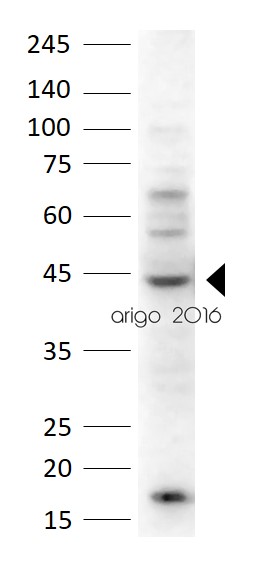ARG63597
anti-NDRG1 antibody
anti-NDRG1 antibody for IHC-Formalin-fixed paraffin-embedded sections,Western blot and Human,Mouse,Rat
Cancer antibody; Gene Regulation antibody; Neuroscience antibody

Overview
| Product Description | Goat Polyclonal antibody recognizes NDRG1 |
|---|---|
| Tested Reactivity | Hu, Ms, Rat |
| Tested Application | IHC-P, WB |
| Specificity | The variants (NP_006087.2; NP_001128714.1) encode the same protein |
| Host | Goat |
| Clonality | Polyclonal |
| Isotype | IgG |
| Target Name | NDRG1 |
| Antigen Species | Human |
| Immunogen | GNSAGPKSMEVSC, corresponding to C terminal amino acids 382-394 of Human NDRG1. |
| Conjugation | Un-conjugated |
| Alternate Names | DRG1; Protein NDRG1; Differentiation-related gene 1 protein; PROXY1; TARG1; RIT42; Reducing agents and tunicamycin-responsive protein; Rit42; CMT4D; RTP; CAP43; N-myc downstream-regulated gene 1 protein; TDD5; HMSNL; NMSL; Nickel-specific induction protein Cap43; NDR1; DRG-1; GC4 |
Application Instructions
| Application Suggestion |
|
||||||
|---|---|---|---|---|---|---|---|
| Application Note | WB: Recommend incubate at RT for 1h. IHC-P: Antigen Retrieval: Steam tissue section in Citrate buffer (pH 6.0). * The dilutions indicate recommended starting dilutions and the optimal dilutions or concentrations should be determined by the scientist. |
Properties
| Form | Liquid |
|---|---|
| Purification | Purified from goat serum by antigen affinity chromatography. |
| Buffer | Tris saline (pH 7.3), 0.02% Sodium azide and 0.5% BSA. |
| Preservative | 0.02% Sodium azide |
| Stabilizer | 0.5% BSA |
| Concentration | 0.5 mg/ml |
| Storage Instruction | For continuous use, store undiluted antibody at 2-8°C for up to a week. For long-term storage, aliquot and store at -20°C or below. Storage in frost free freezers is not recommended. Avoid repeated freeze/thaw cycles. Suggest spin the vial prior to opening. The antibody solution should be gently mixed before use. |
| Note | For laboratory research only, not for drug, diagnostic or other use. |
Bioinformation
| Database Links | |
|---|---|
| Background | This gene is a member of the N-myc downregulated gene family which belongs to the alpha/beta hydrolase superfamily. The protein encoded by this gene is a cytoplasmic protein involved in stress responses, hormone responses, cell growth, and differentiation. The encoded protein is necessary for p53-mediated caspase activation and apoptosis. Mutations in this gene are a cause of Charcot-Marie-Tooth disease type 4D, and expression of this gene may be a prognostic indicator for several types of cancer. Alternatively spliced transcript variants encoding multiple isoforms have been observed for this gene. [provided by RefSeq, May 2012] |
| Research Area | Cancer antibody; Gene Regulation antibody; Neuroscience antibody |
| Calculated MW | 43 kDa |
| PTM | Under stress conditions, phosphorylated in the C-terminal on many serine and threonine residues. Phosphorylated in vitro by PKA. Phosphorylation enhanced by increased intracellular cAMP levels. Homocysteine induces dephosphorylation. Phosphorylation by SGK1 is cell cycle dependent. |
Images (4) Click the Picture to Zoom In
-
ARG63597 anti-NDRG1 antibody IHC-P image
Immunohistochemistry: Paraffin-embedded Human prostate tissue. Antigen Retrieval: Steam tissue section in Citrate buffer (pH 6.0). The tissue section was stained with ARG63597 anti-NDRG1 antibody at 2.5 µg/ml dilution followed by AP-staining.
-
ARG63597 anti-NDRG1 antibody IHC-P image
Immunohistochemistry: Paraffin-embedded Human hepatocelluar carcinoma tissue stained with ARG63597 anti-NDRG1 antibody at 0.5 µg/ml dilution.
-
ARG63597 anti-NDRG1 antibody WB image
Western blot: 35 µg of Human kidney (A), cerebellum (B) and testis (C) lysates (in RIPA buffer) stained with ARG63597 anti-NDRG1 antibody at 0.1 µg/ml dilution and incubated at RT for 1 hour.
-
ARG63597 anti-NDRG1 antibody IHC-P image
Immunohistochemistry: Paraffin-embedded Human colon tissue. Antigen Retrieval: Steam tissue section in Citrate buffer (pH 6.0). The tissue section was stained with ARG63597 anti-NDRG1 antibody at 2.5 µg/ml dilution followed by AP-staining.
Customer's Feedback
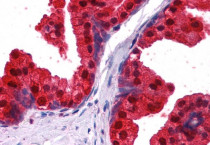
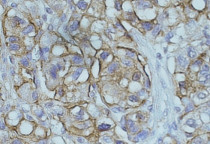
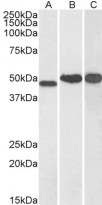
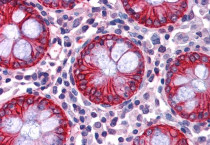
 Excellent
Excellent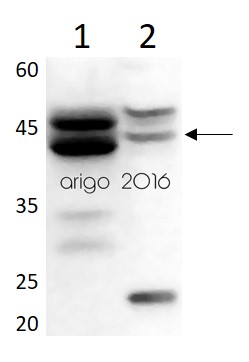

 Good
Good